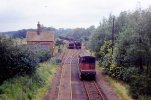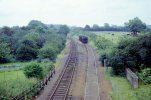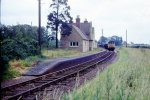Xenophon PCDGS
Veteran Member
Has anyone any knowledge of the type of passenger services that called at this station and the name of the line it was on.
Thanks for this detailed information above. It seems that Twywell lost its passenger service earlier than the other stations on that line.
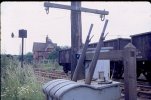
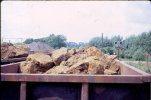
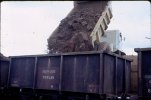
Thank you. Not sure why I was convinced it was Cranford, but there were no nameboards and I was probably didn't want to ask too many questions in the circumstances.Thats tywell stn in the photo
Bit more information (from "Encyclopaedia of British Railway Companies"). Originally authorised in 1862 as the Kettering and Thrapstone* Railway, independent but backed by the Midland Railway (MR). MR then planned an extension to Huntingdon and St Ives sanctioned in 1863 and the railway changed its name to the Kettering, Thrapstone & Huntingdon Railway (KT&HR). Opened to goods February 1866 and passengers in March that year. Line worked by the MR under a 'Perpetual Agreement'. The MR also had running powers over the Eastern Counties Railway between St Ives and Cambridge. The KT&HR was invested in the MR in August 1897.......
Wiki would suggest that the Kettering -- Huntingdon section originated in 1866 as the nominally independent Kettering, Thrapston & Huntingdon Railway: worked from the outset by the Midland Railway; and -- it would seem -- by the time of the Grouping, totally incorporated in the MR.
Bit more information (from "Encyclopaedia of British Railway Companies"). Originally authorised in 1862 as the Kettering and Thrapstone* Railway, independent but backed by the Midland Railway (MR). MR then planned an extension to Huntingdon and St Ives sanctioned in 1863 and the railway changed its name to the Kettering, Thrapstone & Huntingdon Railway (KT&HR). Opened to goods February 1866 and passengers in March that year. Line worked by the MR under a 'Perpetual Agreement'. The MR also had running powers over the Eastern Counties Railway between St Ives and Cambridge. The KT&HR was invested in the MR in August 1897.
*Spelling as per the railway's acts.
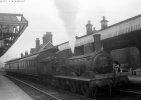
Great pictures. Do you have any more?Reading this thread has made me realise how what I thought were clear memories are now in doubt.
About 1968 I managed to ride the brakevan on a trip down the branch from Kettering to the ironstone loading point on the branch. I always had in my mind that this was at Cranford, but Wagonshop above cleatly remembers it as Twywell.
So for what it's worth, might be Cranford not Twywell, here's the photos; showing the station and ground frame; unloading from tipper; and departing (behind an immaculate D69).
View attachment 86846View attachment 86847View attachment 86848
I'd previously never heard of Twywell but became very interested when I saw that it was situated on the Cambridge-Kettering line and thus have whiled away a good couple of hours researching the history of the line, not least because of an early childhood memory of standing on the road bridge at Kimbolton peering down at the station and the line which was still extant. Having noted that Calthrop had stated that the line closed June 1959, I was questioning my memory because for me to remember that particular image it must have been the early 1960's, and I have since discovered that some kind of freight service (Agricultural products?) existed until 1963. I do recall that the station was some distance from Kimbolton itself, about 2 miles, apparently.
I've attached a photograph taken by my father on 7-Aug-54 at Kettering of a train from Cambridge. I would think that it has recently arrived (behind the J15) and is facing north, but I have read this afternoon that Cambridge trains used a bay platform at the south end of the station (tho' perhaps not all the time!)
I would dearly love to have a 40 odd mile trundle along this line now behind a J15 - probably a couple of hours? - through an area that I knew quite well as a child.View attachment 86869
For history of St. Ives (Hunts) to Huntington and other lines serving St. Ives, see:
Thank you! It isn't the first time that I have made such an error when viewing old photographs! Presumably the bay didn't have any way of releasing the loco from the buffers (or did it?). Given the sparse nature of the service on this line I would be surprised if there was a requirement for another loco to haul the return service....having said that I do have a photo of the same J15 on Kettering shed, presumably taken the same day.The train is facing south in Platform no. 2. The bay (Platform no. 1) was situated to the right of the locomotive, out of view.
Thank you! It isn't the first time that I have made such an error when viewing old photographs! Presumably the bay didn't have any way of releasing the loco from the buffers (or did it?). Given the sparse nature of the service on this line I would be surprised if there was a requirement for another loco to haul the return service....having said that I do have a photo of the same J15 on Kettering shed, presumably taken the same day.
Between Buckden and Huntingdon (East) this line crossed the River Ouse on a low level rickety weak bridge, which necessitated the use of light locomotives. No doubt this contributed to this section of line being completely closed first.
Raunds, Kimbolton and Buckden stations were all very well out of the places they purported to serve, and it hardly surprising that motor vehicles (both lorries and buses) took away what little trade they must have ever had.
All hypothetical and "moot", in view of the actual dates at which things happened; but looking at the road atlas, scale 1:200,000: it occurs to me to wonder whether -- had the Huntingdon end of the line remained in traffic for some years longer than in fact was the case -- the demise of that section anyway, might have been caused by the creation of the large Grafham Water reservoir. Although the atlas does not show the route of the old line; it would appear to me that either the northernmost part of the reservoir would have flooded a stretch of it -- or the line would have been untouched, but by only a narrow margin !
Regarding the operation at Kettering the photos I have all show the branch trains departing from the up slow (through) platform. My own recollection is that the bay behind the up slow was used for Northampton trains. These were extensions of the Northampton - Wellingborough service and were push-pull, so the question of engine release in the bay would not arise.
Someone has a distinct recollection that the signs at Raunds were all E.R. dark blue. I would have guessed that the regional boundary was Huntingdon,
On the subject of the bay platform use, I had a similar thought to you and looked up the Summer 1956 timetable, and the short answer is that there were no Kettering-Northampton trains at that time.
Aside from the two Cambridge trains, the only southbound 'starting' services from Kettering, on weekdays, were 7.5am to St Pancras and 2.36pm to Bedford.
The Cambridge trains left at 8.33am and 5.25pm (8am and 8.12pm Saturdays). There was also a 2.9pm, which is shown as a through train from Leicester dep 1pm to Cambridge, so presumably always departing from the up slow (through) platform, as would the Saturday 8.14am Leicester-Clacton, due to leave Kettering at 9.11am.
At that time, the only extensions of the Northampton-Wellingborough Midland Road service were 1.48pm(SO)/1.58pm(SX) Northampton to Nottingham Midland (routed via Kettering/Manton/Melton Mowbray), 8.45pm Leicester London Rd-Northampton(routed via Mkt Harborough/Kettering) and an odd 10.43pm (SO) Northampton-Kettering.
I think there was a bit of a timetable re-organisation when the Northampton-Market Harborough direct local service was withdrawn, which produced a few workings as you mention. Unfortunately the next timetable edition in my possession is Winter '64 and the Northampton-Wellingborough line has been closed!
A color photograph of a train at Raunds taken on the last day of service has recently been published in a book (can't think which one, possibly by 'Capital Transport'?) and indeed the station signs appear to be E.R. blue.
Great pictures. Do you have any more?
